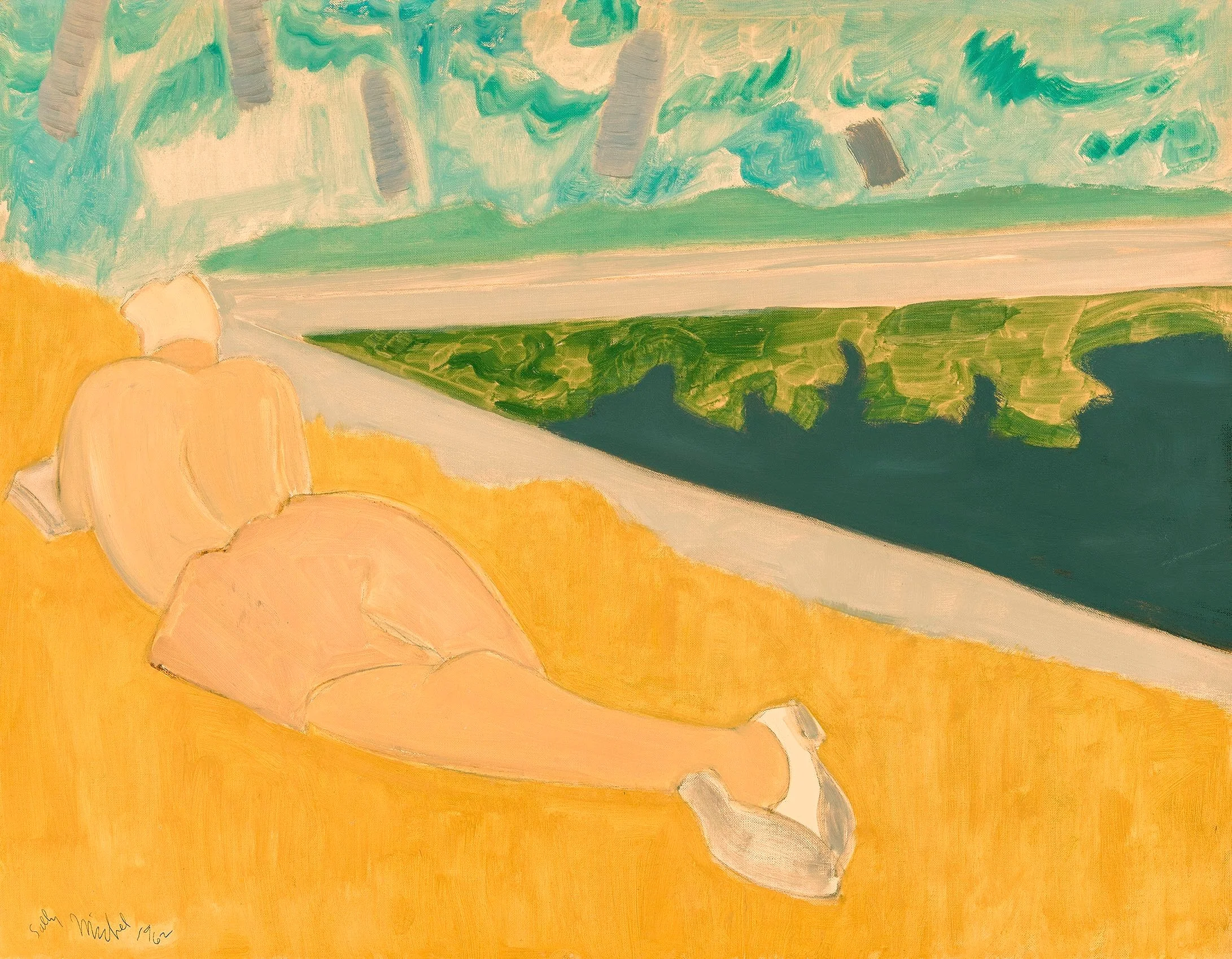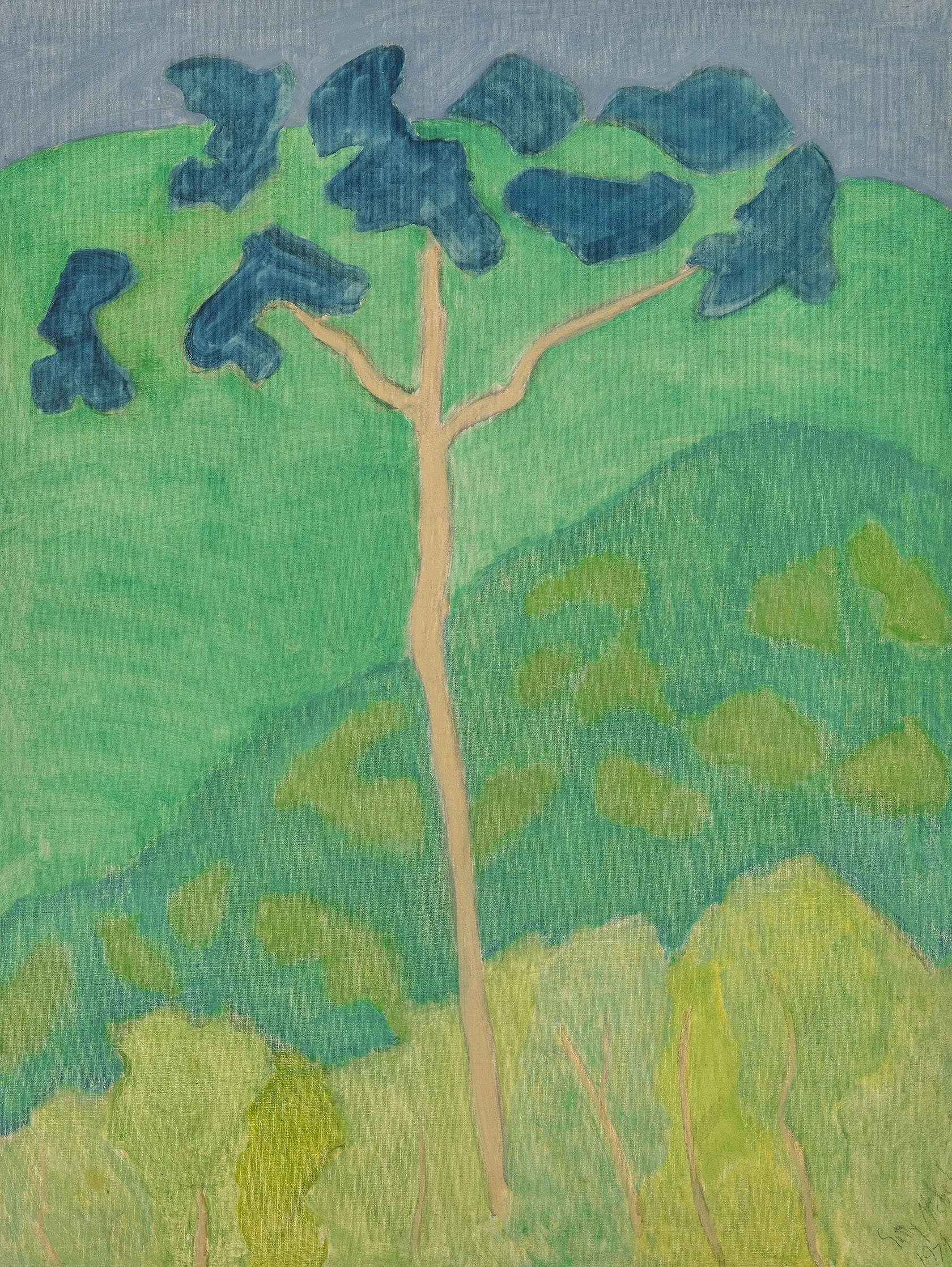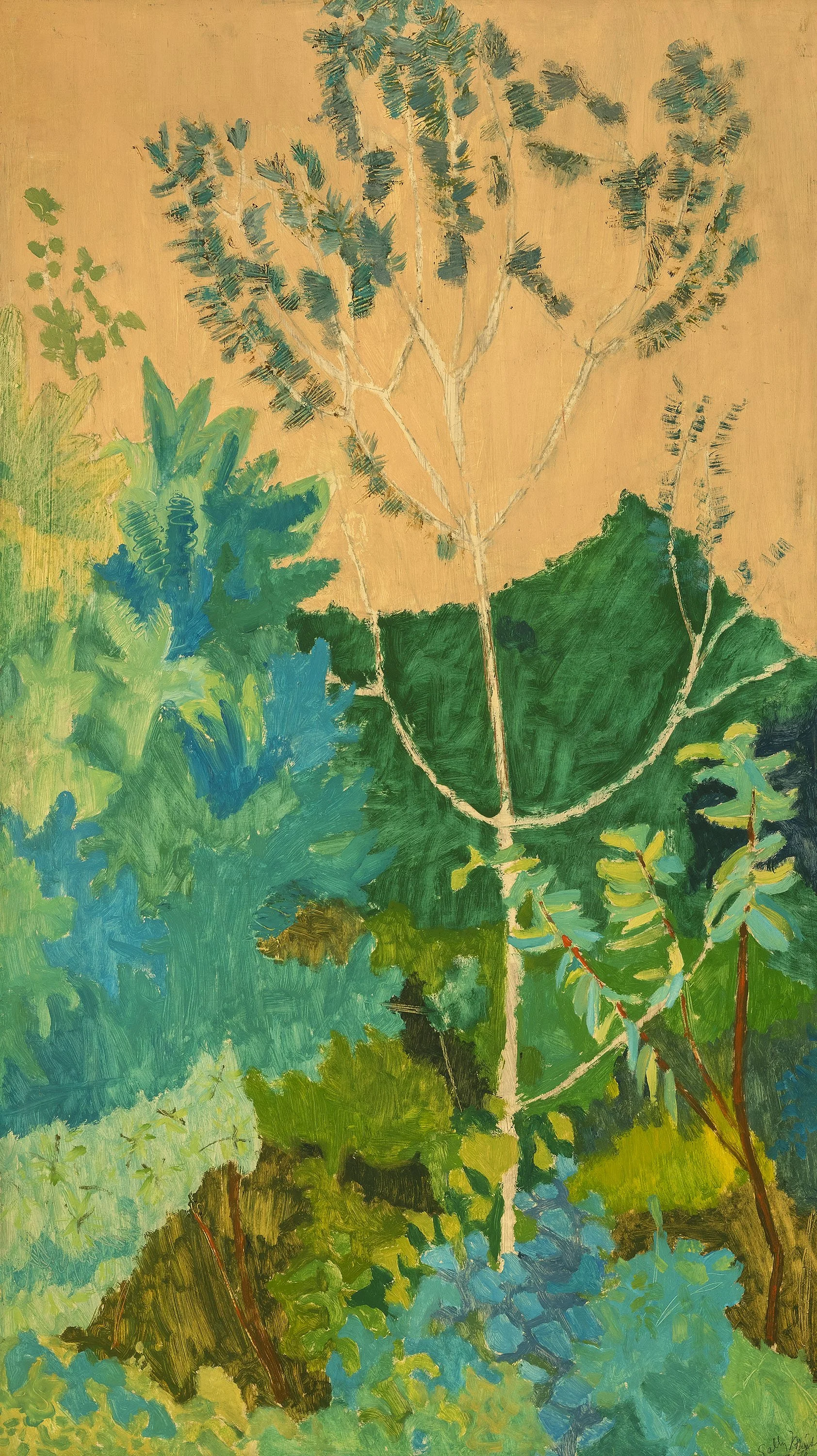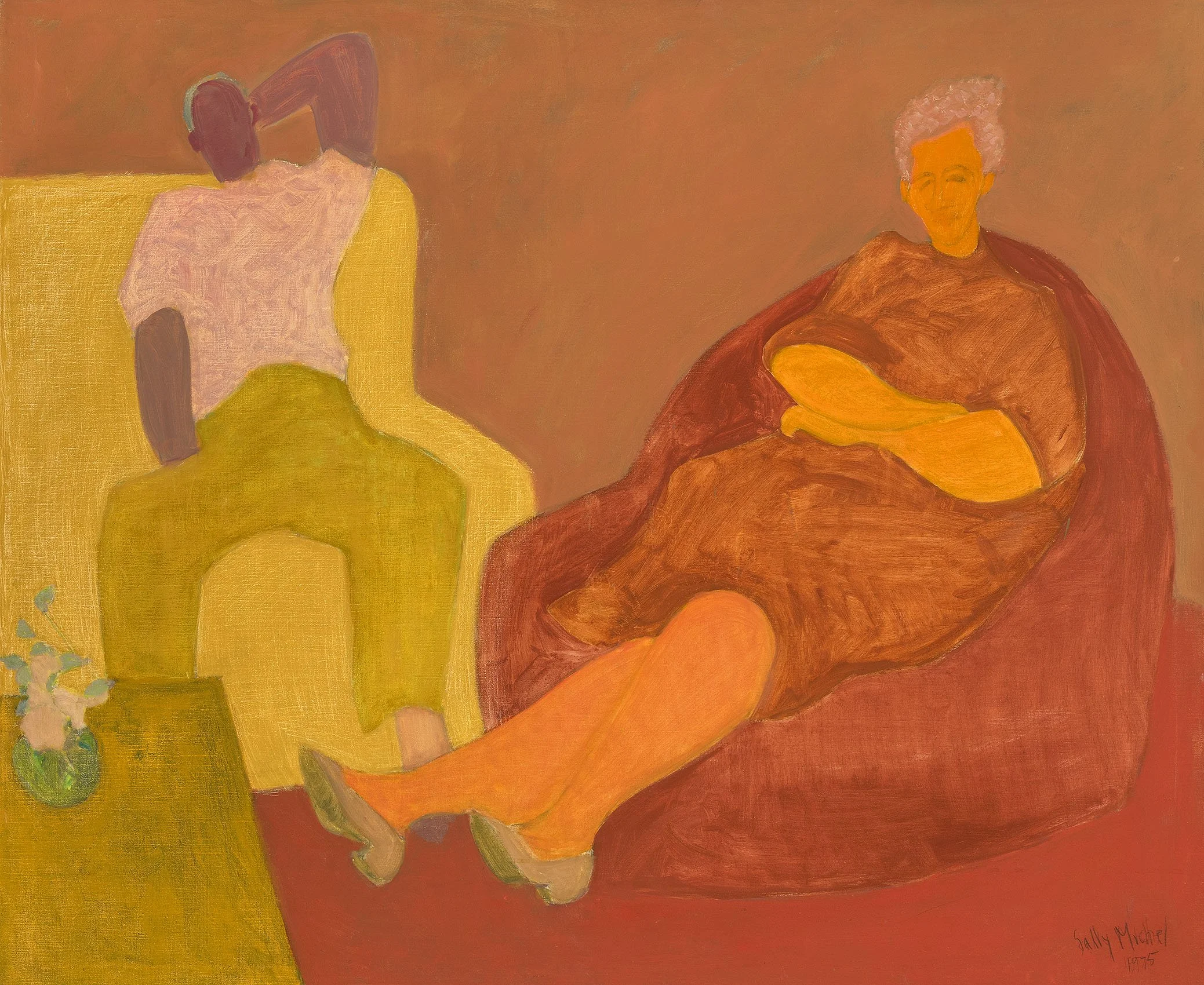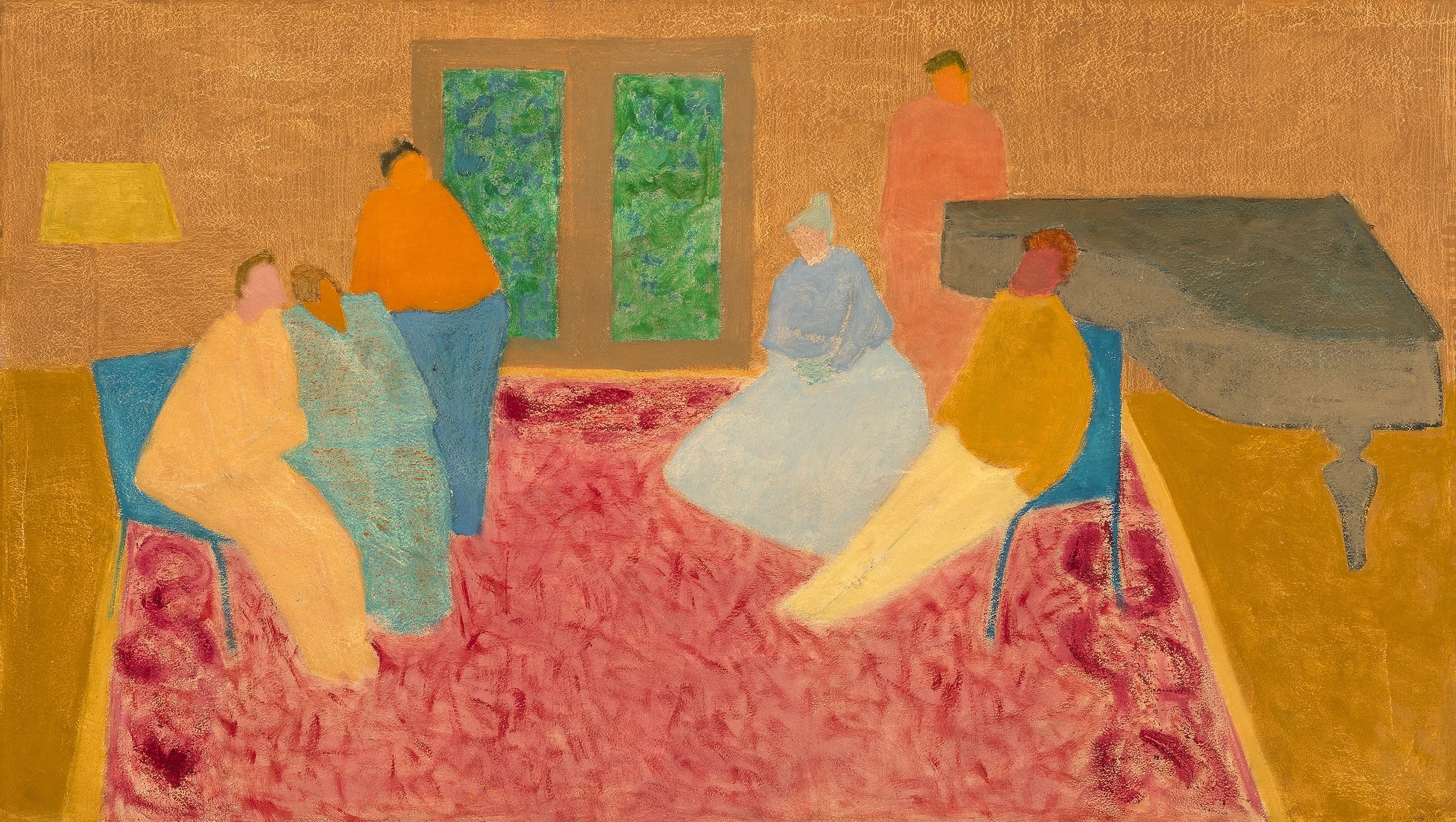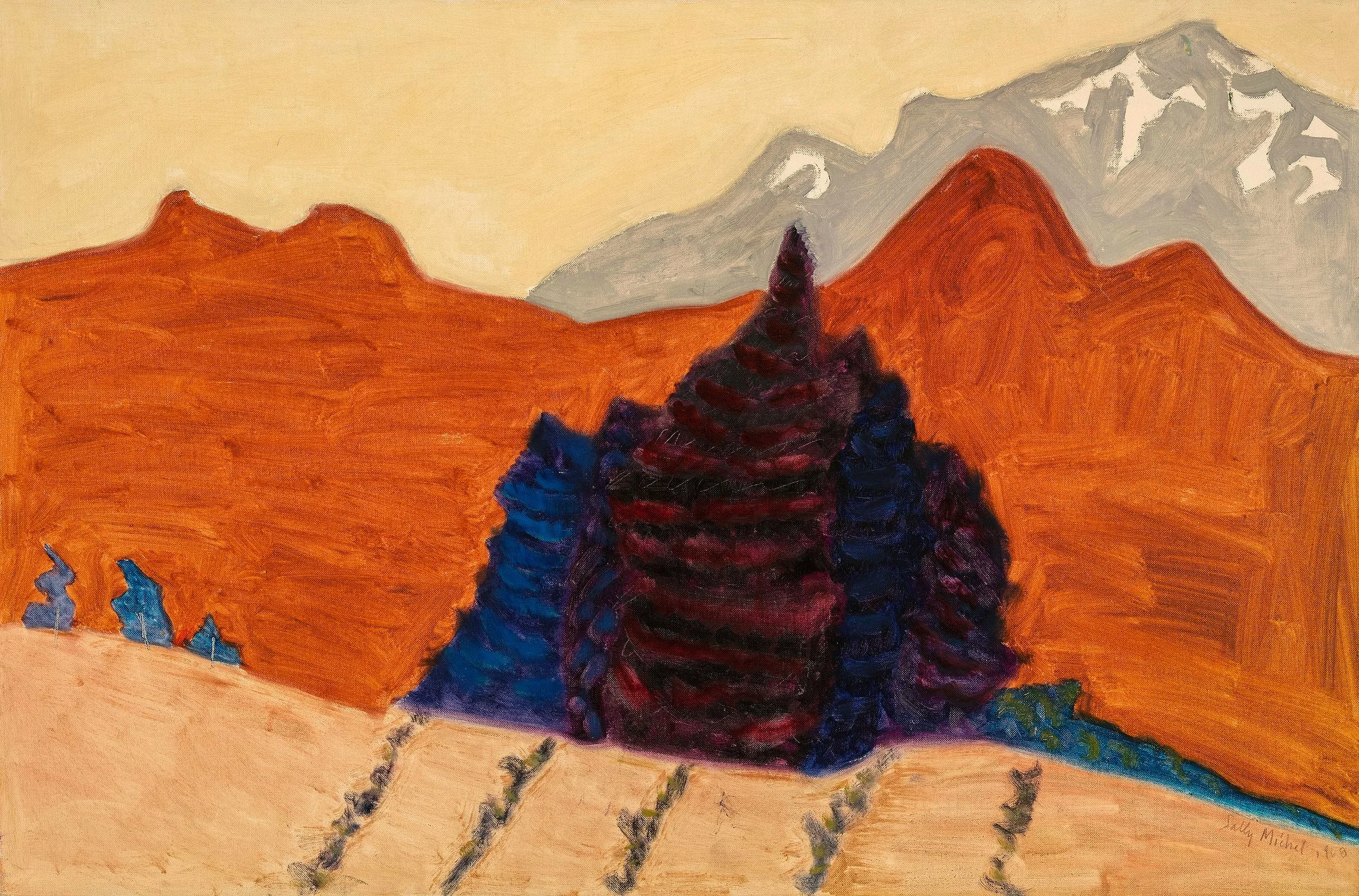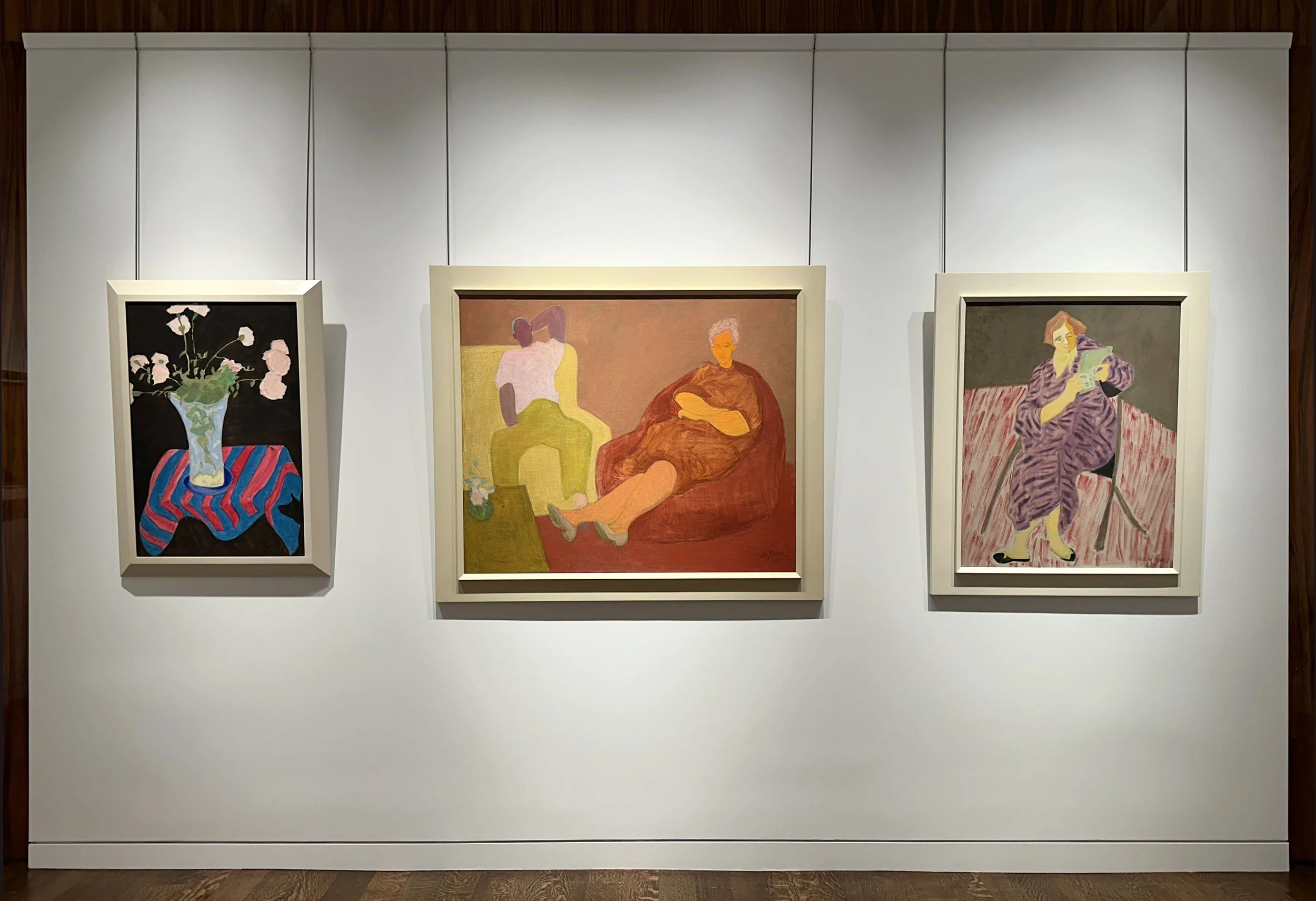May 8 - June 28, 2024
Installation Views | Essay | Exhibition History | Museum Collections | For availability and pricing, call 212-581-1657
Installation Views
Essay by Deedee Wigmore
In the 1940s when Abstract Expressionism was gaining recognition, it was argued that the subconscious was the source of all art. Sally Michel and her husband Milton Avery did not agree with this. They felt that the natural world offered a constantly changing supply of art ideas and focused on how to make representational paintings comparably modern. To achieve this the Averys had to find a way to paint figuration, landscapes, seascapes, and still lifes that bridged the gap between representational and abstract painting. To refresh and move realism forward, they discovered areas in which the opposing styles of realism and abstraction shared artistic problems- areas in which artists in both styles were seeking solutions to achieve exciting compositions. Over time, the Averys found their answer in the simplification of forms, new uses of color, and a modern feeling of flatness. These changes allowed realism to absorb new life and transform without losing its distinctive qualities.
Milton Avery (1885-1965) and Sally Michel (1902-2003) met painting in Gloucester, Massachusetts in 1924. They admired each other’s dedication to art. Married in 1926, Sally and Milton worked in New York as a unit until Milton’s death in 1965. To provide support, Sally worked as a freelance illustrator, an occupation she could pursue at home. This allowed her to remain with Milton and their young daughter and continue to develop her own painting. The couple would rise at six in the morning and draw or paint straight through to dinner. Sally was gregarious and Milton was taciturn, so she became his spokesman. Saturdays were spent in New York’s galleries and museums. To continue developing skills and new directions they sketched from a model at the Art Students League and later with a group of their friends at each other’s studios. Through the 1930s, fellow artists of Sally’s generation, including Mark Rothko, Adolph Gottlieb, and Barnett Newman, frequently came to the Avery home to discuss art. By the mid-1940s Milton and Sally each developed their own parallel but unique approaches to painting.
Choppy Lake, c. 1950s
The refinement of their artistic visions evolved over many years of sketching, painting, looking, and sharing ideas on art. The Averys structured their year so that summers were spent on long sketching trips of non-stop drawing to gather source material for future paintings to be executed in the studio. With limited funds the Averys drove to summer locations in Connecticut (1930), Gloucester, Massachusetts (1926-1933), Vermont (1937, 1939, 1940), and the Gaspé Peninsula, Québec (1938). In the 1940s they traveled further: California with stops in Yellowstone and Glacier National Parks (1941); Mexico (1946); and the Canadian Northwest and Oregon (1947). After their 1952 trip to Europe, the Averys’ later years saw summers spent closer to home: Woodstock, New York; the art colonies Yaddo (1955) and MacDowell (1953, 1954, 1956); and Provincetown, Massachusetts (1957-1961). Under doctor’s orders, Milton spent the winters of 1949-1950 and 1950-1951 recuperating from a heart attack in Maitland, Florida where he and Sally were Bok Fellows at The Research Studio. Later they wintered in Key West, Florida in 1959.
Flowered Kimono, 1963
This exhibition presents Sally Michel’s oil paintings from 1950 to 1986. Sally painted directly from nature throughout her career, using sketches to further develop paintings in the studio. The verdant Mountain Landscape (1959) and seaside activities in Provincetown Pier (c. 1957-61) reflect summer sketching trips made to the art colonies of MacDowell, Yaddo, Provincetown, and Woodstock. In the studio an intermediary watercolor or gouache could recall a location and inform the finished oil by transmitting a mood, time of day, weather, or season. The fluidity and luminosity of gouache and watercolor provided freedom to experiment with color and tone for a new sensual approach to color. The desired effects of color and light found in the use of watercolor and gouache could be duplicated in oil on canvas by painting with thinned pigments. For overall softness, Sally used a stiff brush to apply matte paint in thin layers. For textural contrasts, Sally would scrape or scratch into thick paint, as seen in the water of Choppy Lake. In reviewing sketches to select one to paint, Sally considered different views, straight or curving lines, and scale. Patterning was used for movement or to imply actual motion. The patterned dress in Flowered Kimono (1963) moves the viewer from the lower left corner to the upper right corner. In Violet (1966), the patterns of the carpet and dress suggest the sitter is an energetic dynamo. Sally’s portraits of individuals were often close-ups isolated against flat backgrounds. Scale distortion, exaggerated color, or caricature could provide social commentary when she desired it. Sally Michel’s sketch-to-painting approach aided her to find simplified and abstracted shapes that locked together in finely balanced compositions.
Landscape, 1953-1955
Milton Avery and Sally Michel were dedicated to painting what they saw at a time when realism as a style was not deemed modern. They found bridges between realism and abstraction in color, structure, and light. Sally’s paintings Shore (c. 1950s) and Delicate Tree (1974) demonstrate that shapes, spaces, and color form their own relationships independent of subject matter. The Averys modernized realism by using the shapes of things and the spaces around them in new ways. Colors were selected to reflect mood and transcend the specific subjects depicted. Realism traditionally relies on light and dark contrasts to create depth. The use of non-associative color suppresses that contrast and creates a new challenge to find another way to produce depth, as seen in Landscape (1953-55). The Averys found that a highly structured composition would still be read as a landscape, still life, or figure. Poolside Reader (1962) and Orchard in Bloom (1956) are examples of this. With careful attention to shapes and their edges in paintings, Sally and Milton were able to capture further universality and interconnections. Their use of thinly applied paint so the canvas ground was revealed around the edges of shapes allowed the bare canvas to function as color. The intricate color shifts of land, sand, and sea in Sally’s Shore demonstrate how the boundaries of soft shapes help the viewer determine transitions that imply depth. These adjustments to solve artistic problems led to a new and important discovery; that the distinctions between objects in a painting are fundamentally illusions and the borders between shapes are what create representational art. The Averys achieved further modernity by reducing the number of shapes and colors in a painting and eliminating illusionistic rounded volumes and modeled forms. When the Averys began to use shapes as containers of color in both figuration and landscape, shape and color became equal. Examples of this include Evening Relaxation (1975) and Western Landscape (1968). Containers of color could be stacked as abstract signs of foreground, middle ground, distance, and sky. Organic and geometric patterns, as well as liquid or transparent areas of paint, could express the forces of wind and water as well as the light and forms of nature. In their paintings, Milton Avery and Sally Michel demonstrated that art movements as far apart as Abstract Expressionism and realism have overlapping aims, attitudes, and methods and that new ideas about style can be absorbed and transformed without losing the distinctive qualities of either realism or abstraction.
Sketcher with Plant, 1975
After Milton’s passing in January of 1965, Sally worked tirelessly to ensure Milton’s legacy and continued to evolve her use of art materials for another twenty-five years. To develop her dry surface and characteristic soft matte feel, Sally mixed large amounts of turpentine with her paint. Always frugal with pigment, Sally used rags to moderate layers of color in a shape and provide contrasts in texture. When she wanted textural interest or to bring attention to the two-dimensional surface of a canvas, she scratched into the paint. All of this can be seen in the carefully structured colors and the contrasting textures in Twilight (1974). Sally added luminosity by tinting colors with white pigment. She also made daring experiments with color harmonies seen in paintings like Sketcher With Plant (1975). Sally Michel worked to achieve mood and movement rather than detailed representation in her paintings. She continued the careful selection and placement of the elements of her subject, use of non-associative color choices, and attention to the edges of her reductive forms to achieve flattened compositions. Sally found her imagery in the visible world, often inspired by her own travels. By understanding and adapting elements from the two streams of art -representation and abstraction- Sally Michel was able to keep realism relevant and modern.
The Mennello Museum of American Art in Orlando, FL will open an exhibition with catalogue on Sally Michel in September 2024. Both Sally and Milton were artists-in-residence at The Research Studio nearby in Maitland the winters of 1950-51 and 1951-52.
Exhibition History
Selected Solo Exhibitions
1957
Village Art Center, New York, NY
1979
Sally Michel: Mountain Landscapes, The Erpf Catskill Cultural Center, Arkville, NY.
1982
Ulster County Council for the Arts, Kingston, NY.
1985
Kleinert Gallery, Woodstock, NY (now the Byrdcliffe Kleinert/James Center for the Arts).
1987
Sally Michel: The Other Avery, University of Iowa Museum of Art, Iowa City, IA. Robert Hobbs, curator. Exhibition traveled through 1988.
1990
Fresno Art Museum, California. Catalogue with essay by Nancy Acord.
1999-2000
Sally Michel: Retrospective, Danforth Museum of Art, Framingham, MA.
2024
Sally Michel: Abstracting Tonalism, Mennello Museum of American Art, Orlando, FL. Opens September 20th.
Selected Group Exhibitions
1933
Painting and Sculpture by Wives of Painters and Sculptors, Contemporary Arts Gallery, New York.
1950
New York City Center Gallery, New York, NY.
Woodstock Art Center, New York.
Sid Deutsch Gallery, New York, NY.
1956
Village Art Center, New York, NY (First Prize – oil paintings).
1957
Village Art Center, New York, NY (Second Prize – drawings).
1959
Two Husband and Wife Painting Teams, Rudolph Galleries, Coral Gables, FL (Sally Michel, Milton Avery, Arnold Blanch, and Doris Lee).
Paul Kessler Gallery, Provincetown, MA (also 1965-1967).
1962
Milton Avery, Sally Michel, March Avery, New Arts Gallery, Atlanta, GA.
Mr. and Mrs. Show, Gallery 14, Inc., Palm, Beach, FL (c. 1962).
1963
Avery Family Group Show. Rye Free Reading Room, New York.
1966
Milton Avery and Family: “An Album of a Contemporary Family of Artists,” Gallery Reese Palley, Atlantic City, NJ. Catalogue.
1968
The Milton Avery Family, The New Britain Museum of American Art, Connecticut. Catalogue.
1971
Paintings by Milton Avery and His Family, Allentown Art Museum, Pennsylvania. Catalogue with text by Frank Getlein.
1977
Woodstock, An American Art Colony, 1902-1977, Vassar College Art Gallery, Poughkeepsie, NY.
1985
The Avery Family: Milton Avery, Sally Michel, March Avery– An Exhibition of Paintings, Saint Joseph College, West Hartford, CT.
1986
American Masters: Works on Paper from The Corcoran Gallery of Art, Smithsonian Institution Traveling Exhibition Service and Corcoran Gallery of Art, Washington, DC, 1986. Traveled to: Oklahoma Museum of Art, Oklahoma City, OK; Queens Museum, Flushing, NY; Corcoran Gallery of Art, Washington, DC; Burling Library, Grinnell, IA; Cincinnati Art Museum, Ohio; The Society of the Four Arts, Palm Beach, FL. Catalogue with essays by Edward J. Nygren and Linda Crocker Simmons.
1987
Seventy-five American Modernists, Corcoran Gallery of Art, Washington, DC.
1989-90
American Women Artists: The Twentieth Century, Knoxville Museum of Art, Tennessee. In conjunction with Bennett Galleries, Knoxville, TN. Traveled to Queensborough Community College Art Gallery, Bayside, NY. Catalogue with text by Elsa Honig Fine and essay on Sally Michel by Robert Hobbs.
1994-96
Relatively Speaking: Mothers and Daughters in Art, Sweet Briar College Art Gallery, Virginia, 1994; The Newhouse Center for Contemporary Art, Snug Harbor Cultural Center, Staten Island, NY, 1994-1995; Rockford Museum of Art, IL, 1995; Rahr-West Museum, Manitowoc, WI, 1995; Hofstra Museum, Hofstra University, Hempstead, NY, 1996. Catalogue with essays by Charlotta Kotik and Judith Swirsky.
1997-98
Preserving the Past, Securing the Future: Donations of Art, 1987-1997, National Museum of Women in the Arts, Washington, DC.
2001
Celebration of the Horse, Marietta/Cobb Museum of Art, Atlanta, GA.
2003
Sally Michel/Milton Avery: A Portrait, Knoedler & Company, New York, NY.
2015-16
Provincetown Artists: A Survey of American Modern to Abstract Art, Walter J. Manninen Center for the Arts, Endicott College, Beverly, MA.
2019
Summer with the Averys: Milton / Sally / March, Bruce Museum, Greenwich, Connecticut. Catalogue with text by Kenneth E. Silver and interview with March Avery by Stephanie Guyet.
2022
Arriving at Byrdcliffe, Kleinert/James Center for the Arts, Woodstock Byrdcliffe Guild, New York.
2023
In Care of the Historical Society of Woodstock: Selected Survey of Woodstock Art Colony Works on Paper, Historical Society of Woodstock, NY.
Fellowships
Bok Fellows, The Research Studio, Maitland, FL (1949/1950, 1950/1951)
MacDowell Colony Fellowship, Peterborough, NH (1953, 1954, and 1956)
Yaddo Fellowship, Saratoga Springs, NY (1955)
Museum Collections
Albuquerque Museum, New Mexico
Art & History Museums, Maitland, FL
Art Museum, University of Saint Joseph, Hartford, CT
Brooklyn Museum, New York
Bryn Mawr College Art & Artifacts Collections, Pennsylvania
Cape Ann Museum, Gloucester, MA
Chrysler Museum of Art, Norfolk, VA
Fresno Art Museum, California
Harn Museum of Art, Gainesville, FL
Housatonic Museum of Art, Bridgeport, CT
Israel Museum, Jerusalem
Kemper Museum of Contemporary Art, Kansas City, MO
Mattatuck Museum, Waterbury, CT
Mennello Museum of American Art, Orlando, FL
Metropolitan Museum of Art, New York, NY
Mount Holyoke College Art Museum, South Hadley, MA
National Gallery of Art (Corcoran Collection), Washington, DC
National Museum of Women in the Arts, Washington, DC
National Portrait Gallery, Washington, DC
New Britain Museum of American Art, Connecticut
Pennsylvania Academy of the Fine Arts, Philadelphia
Provincetown Art Association and Museum, Massachusetts
Reading Public Museum, Pennsylvania
Smith College Museum of Art, Northampton, MA
University of Iowa Museum of Art, Iowa City, IA
University of St. Thomas–Minnesota, Saint Paul, MN
Wadsworth Atheneum Museum of Art, Hartford, CT
Westmoreland Museum of American Art, Greensburg, PA
Woodstock Artists Association and Museum, New York
